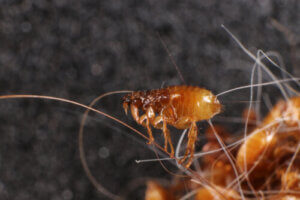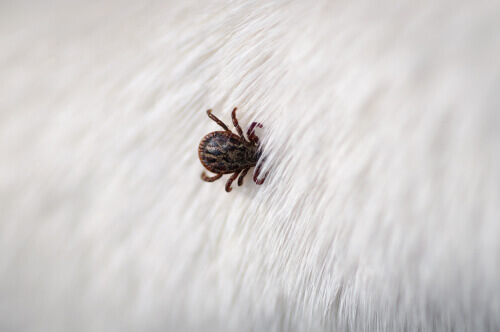Why It's Important to Prevent Parasites in Pets


Written and verified by the biologist Samuel Sanchez
Most owners, at some point or another, have seen a flea or a tick in their dog’s fur. Human beings and other animals live along with parasites naturally. And these creatures come in different shapes and sizes, which allow them to invade our bodies as effectively as possible. Just the same, the dangers that these living beings can produce go far beyond a mere bite or minor injury. Today, we want to tell you about why it’s so important to prevent parasites in pets.
The world of parasites
Ironically, parasitism is a type of symbiosis. That’s because it’s an interaction where one of the two components (the parasite) obtains some sort of benefit. The host, however, pays a price in almost every case.
There are different types of parasites according to their location in the animal’s body:
- Ectoparasites: These creatures live in contact with the exterior of the host. For example, fleas, ticks, and mosquitos. Because we can observe them easily with our bare eyes and interact with them, these are the most well-known parasites.
- Endoparasites: These live inside the host’s body and consist of two different types. One the one hand, we have extracellular endoparasites, which live outside of the cells of a specific tissue). For example, tapeworm attaches to the surfaces of the intestinal mucus membrane and feeds off animals. Then, on the other hand, we have intracellular endoparasites, which live inside tissue cells. While it may seem strange, viruses are sometimes considered intracellular parasites, since the invade the cells and reproduce in them.
- Mesoparasites: Part of the parasite’s body is outside of the animal’s body and the other part is anchored inside the animal’s tissue. These are the least common type of parasite.
According to the parasite’s life cycle, we can also differentiate between two types:
- Obligate parasites: Need a host in order to complete its life cycle. For example, ticks can’t survive without the blood of a vertebrate. Therefore, they must attach to an animal in order to reproduce and produce offspring.
- Facultative parasite: These creatures can infect an animal or develop freely. A variety of fly species can lay eggs on cadavers or live animal tissue depending on the situations. Therefore, they don’t require a live host in order to complete their life cycle.

Why is it so important to prevent parasites in pets?
Most parasites that affect domestic animals are small invertebrates. And while most only produce minor and temporary discomfort, in large quantities or at certain times, they can produce severe illness. Below, we’ll focus on two very important reasons why it’s so important to prevent parasites in pets.
Parasites take advantage of an animal’s nutrients
Most parasites feed on the blood of vertebrates. This liquid is very valuable since it contains proteins, mineral salts, and water. A correct concentration of these elements is necessary in order for the body to carry out vital functions. The presence of parasites can cause various symptoms, including the following:
- Cough
- Vomiting and diarrhea, if parasites are located in the intestinal tract
- Tiredness, fatigue, loss of shine in fur or feathers; in the end, parasites steal protein components that are essential to the animal’s well-being.
- Respiratory problems and fatigue
All of these reasons are important enough to prevent parasites in pets. However, there are more.
Parasites are vectors or even worse illnesses
Given their close relationship with the bloodstream of vertebrates, many microorganisms, like bacteria and protozoa, use parasites as their vehicles of infection. This is why there are so many illnesses from mosquito bites.
An excellent example is that of the flatworm Dipylidium caninum. This worm, in its larva form, waits to be eaten accidentally by a cat or dog while grooming. Once inside the mammal’s body, the larva transforms into an adult that can measure up to some 27 inches long.

The prevention of parasites in pets is an obligation
Dogs, cats, and other small animals including birds are unable to tell us what’s bothering them. Just imagine having a tick on your back, right beyond your reach, that’s constantly biting you. Sounds uncomfortable, doesn’t it?
This is why it’s so important to inspect our pets’ fur on a regular basis, especially during the summer and spring. As pet owners, keeping our pets healthy and free of parasites is our obligation.
Most owners, at some point or another, have seen a flea or a tick in their dog’s fur. Human beings and other animals live along with parasites naturally. And these creatures come in different shapes and sizes, which allow them to invade our bodies as effectively as possible. Just the same, the dangers that these living beings can produce go far beyond a mere bite or minor injury. Today, we want to tell you about why it’s so important to prevent parasites in pets.
The world of parasites
Ironically, parasitism is a type of symbiosis. That’s because it’s an interaction where one of the two components (the parasite) obtains some sort of benefit. The host, however, pays a price in almost every case.
There are different types of parasites according to their location in the animal’s body:
- Ectoparasites: These creatures live in contact with the exterior of the host. For example, fleas, ticks, and mosquitos. Because we can observe them easily with our bare eyes and interact with them, these are the most well-known parasites.
- Endoparasites: These live inside the host’s body and consist of two different types. One the one hand, we have extracellular endoparasites, which live outside of the cells of a specific tissue). For example, tapeworm attaches to the surfaces of the intestinal mucus membrane and feeds off animals. Then, on the other hand, we have intracellular endoparasites, which live inside tissue cells. While it may seem strange, viruses are sometimes considered intracellular parasites, since the invade the cells and reproduce in them.
- Mesoparasites: Part of the parasite’s body is outside of the animal’s body and the other part is anchored inside the animal’s tissue. These are the least common type of parasite.
According to the parasite’s life cycle, we can also differentiate between two types:
- Obligate parasites: Need a host in order to complete its life cycle. For example, ticks can’t survive without the blood of a vertebrate. Therefore, they must attach to an animal in order to reproduce and produce offspring.
- Facultative parasite: These creatures can infect an animal or develop freely. A variety of fly species can lay eggs on cadavers or live animal tissue depending on the situations. Therefore, they don’t require a live host in order to complete their life cycle.

Why is it so important to prevent parasites in pets?
Most parasites that affect domestic animals are small invertebrates. And while most only produce minor and temporary discomfort, in large quantities or at certain times, they can produce severe illness. Below, we’ll focus on two very important reasons why it’s so important to prevent parasites in pets.
Parasites take advantage of an animal’s nutrients
Most parasites feed on the blood of vertebrates. This liquid is very valuable since it contains proteins, mineral salts, and water. A correct concentration of these elements is necessary in order for the body to carry out vital functions. The presence of parasites can cause various symptoms, including the following:
- Cough
- Vomiting and diarrhea, if parasites are located in the intestinal tract
- Tiredness, fatigue, loss of shine in fur or feathers; in the end, parasites steal protein components that are essential to the animal’s well-being.
- Respiratory problems and fatigue
All of these reasons are important enough to prevent parasites in pets. However, there are more.
Parasites are vectors or even worse illnesses
Given their close relationship with the bloodstream of vertebrates, many microorganisms, like bacteria and protozoa, use parasites as their vehicles of infection. This is why there are so many illnesses from mosquito bites.
An excellent example is that of the flatworm Dipylidium caninum. This worm, in its larva form, waits to be eaten accidentally by a cat or dog while grooming. Once inside the mammal’s body, the larva transforms into an adult that can measure up to some 27 inches long.

The prevention of parasites in pets is an obligation
Dogs, cats, and other small animals including birds are unable to tell us what’s bothering them. Just imagine having a tick on your back, right beyond your reach, that’s constantly biting you. Sounds uncomfortable, doesn’t it?
This is why it’s so important to inspect our pets’ fur on a regular basis, especially during the summer and spring. As pet owners, keeping our pets healthy and free of parasites is our obligation.
All cited sources were thoroughly reviewed by our team to ensure their quality, reliability, currency, and validity. The bibliography of this article was considered reliable and of academic or scientific accuracy.
- Parasitismo, wikipedia. Recogido a 19 de junio en https://es.wikipedia.org/wiki/Parasitismo.
This text is provided for informational purposes only and does not replace consultation with a professional. If in doubt, consult your specialist.








